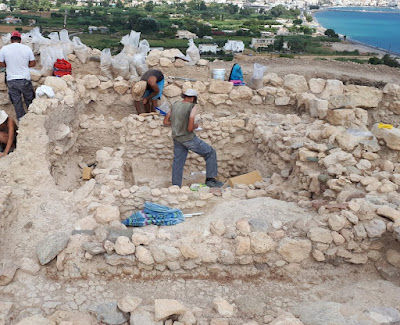As the skeletal material is particularly plentiful in these house tombs the uncovering and the complete documentation of it is a slow, meticulous process carried out by an experienced team of osteoarchologists from the University of Thessaloniki. The archaeological field crew is international in scope as always, coming from the US, Ireland, Australia and Spain, besides Greece. This year I am the sole Canadian, alas. The visit by Professor Angus Smith (President, CIG Board of Directors) and two of his graduate students, Kelsea Dawn and Sydney Bryk, from Brock University provided more Canadian [Brock!] Content, if briefly. Angus presented me with a certificate from the Board of Directors that indicated that my name had been added to the “Honour Roll” plaque at the Institute for my years of service in furthering its mission. I was very touched by the recognition!
While the finds so far have not matched last year’s spectacular series of discoveries, they are nevertheless of great importance. More evidence has been uncovered that demonstrates Petras’ role in the exchange networks from Crete to the eastern Mediterranean and beyond. The number of house tombs is unsurpassed in any other contemporaneous cemetery on the island. Many of the deposits of skeletal remains have ceramic vessels as offerings that permit secure dating of the contexts. And, finally, the excavation of the ceremonial complex that was built directly on top of the ruins of the house tombs in the Post-Palatial period continues to reveal how extensive and varied it was.
This year, as last, the weather was a significant member of our crew. In addition, to the usual heatwaves and then strong winds, an unexpected torrential rainstorm (with much lightning and thunder) struck one morning just before we were about to start our commute to the site at 6:45 am. For over 90 minutes the skies pelted the Siteia region with significant amounts of precipitation. For that day we stayed in and worked on our trench notebooks, of course. The next morning when we reached the excavations we found many of the house tombs that we were excavating had filled with water, ranging from 10 – 70 cm in depth. Until a pump could be found an impromptu bucket brigade formed to bail out the “lakes”. For a week or more afterwards our Munsell readings were of “damp” sediments and not the normal bone “dry”.As in past years I have posted [“Grubbyminoan”] on Instagram a series of images with scenes from the excavations and its diggers at work and at rest, under the hashtag: #petras_excavations_2019. Please check them out!
The final two weeks of an excavation are usually the most challenging with many tasks to complete before it is “closing time” for the summer. A heatwave now would not help. That all awaits us. In the meantime, the sandy beach at Chiona at Palaikastro and a fishy lunch call. The future of the past will happen in due time.
Cordially,
David Rupp
Director Emeritus, CIG






No comments:
Post a Comment